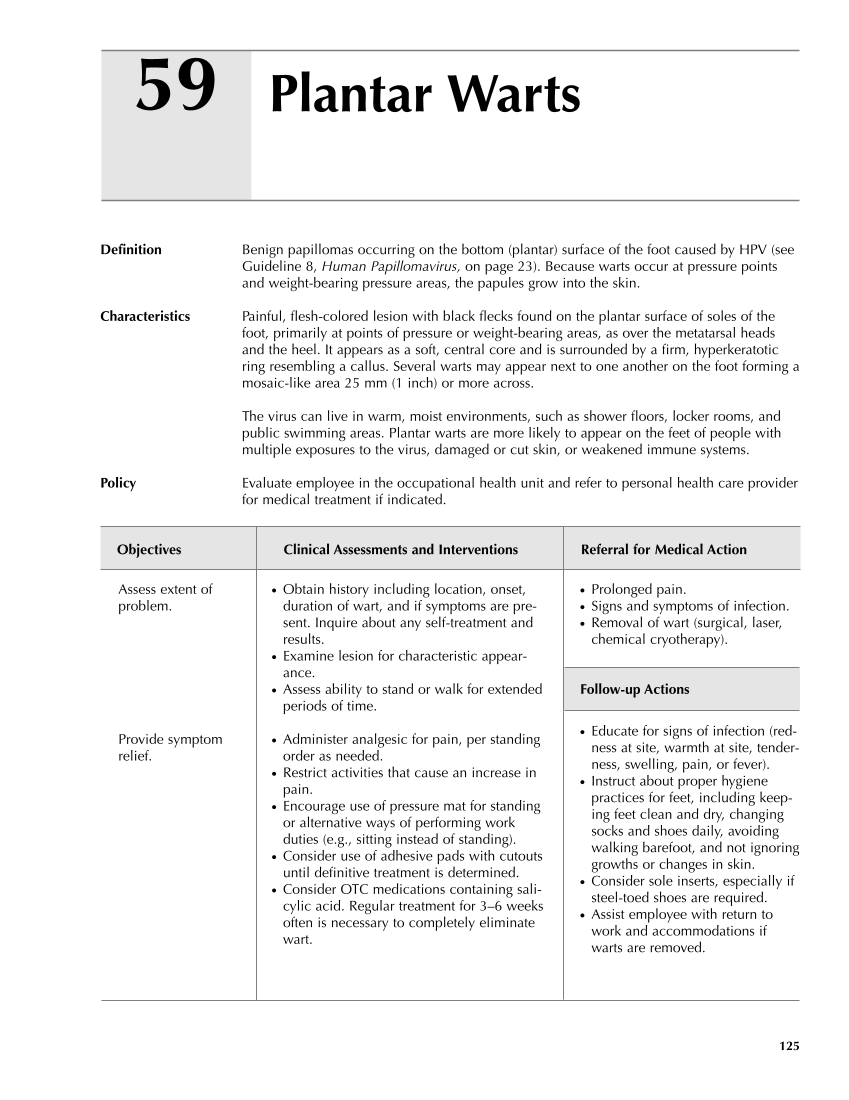125 Plantar Warts 59 Definition Benign papillomas occurring on the bottom (plantar) surface of the foot caused by HPV (see Guideline 8, Human Papillomavirus, on page 23). Because warts occur at pressure points and weight-bearing pressure areas, the papules grow into the skin. Characteristics Painful, flesh-colored lesion with black flecks found on the plantar surface of soles of the foot, primarily at points of pressure or weight-bearing areas, as over the metatarsal heads and the heel. It appears as a soft, central core and is surrounded by a firm, hyperkeratotic ring resembling a callus. Several warts may appear next to one another on the foot forming a mosaic-like area 25 mm (1 inch) or more across. The virus can live in warm, moist environments, such as shower floors, locker rooms, and public swimming areas. Plantar warts are more likely to appear on the feet of people with multiple exposures to the virus, damaged or cut skin, or weakened immune systems. Policy Evaluate employee in the occupational health unit and refer to personal health care provider for medical treatment if indicated. Objectives Clinical Assessments and Interventions Referral for Medical Action ● Prolonged pain. ● Signs and symptoms of infection. ● Removal of wart (surgical, laser, chemical cryotherapy). Follow-up Actions ● Educate for signs of infection (red- ness at site, warmth at site, tender- ness, swelling, pain, or fever). ● Instruct about proper hygiene practices for feet, including keep- ing feet clean and dry, changing socks and shoes daily, avoiding walking barefoot, and not ignoring growths or changes in skin. ● Consider sole inserts, especially if steel-toed shoes are required. ● Assist employee with return to work and accommodations if warts are removed. Assess extent of problem. Provide symptom relief. ● Obtain history including location, onset, duration of wart, and if symptoms are pre- sent. Inquire about any self-treatment and results. ● Examine lesion for characteristic appear- ance. ● Assess ability to stand or walk for extended periods of time. ● Administer analgesic for pain, per standing order as needed. ● Restrict activities that cause an increase in pain. ● Encourage use of pressure mat for standing or alternative ways of performing work duties (e.g., sitting instead of standing). ● Consider use of adhesive pads with cutouts until definitive treatment is determined. ● Consider OTC medications containing sali- cylic acid. Regular treatment for 3–6 weeks often is necessary to completely eliminate wart. Guideline continues on next page
Purchased from OEM Press by (ge corporate access). (C) 2013 OEM Health Information, Inc. All rights reserved.












































































































































































































































































































































































































































